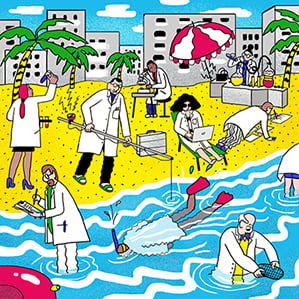Quest to Mine Seawater for Lithium Advances
Researchers at Japan’s Atomic Energy Agency have come up with a new method of processing seawater to extract lithium—an element that plays a key role in advanced batteries for electric vehicles and one that, if current predictions for the EV market prove accurate, could be in short supply before the end of the decade.

Writing in the new issue of the journal Desalination, Tsuyoshi Hoshino, a scientist at the JAEA’s Rokkasho Fusion Institute, proposed a method for recovering lithium from seawater using dialysis. Still years from commercialization, the system is based on a dialysis cell with a membrane consisting of a superconductor material. Lithium is the only ion in the seawater that can pass through the membrane, from the negative-electrode side of the cell to the positive-electrode side.
The method “shows good energy efficiency and is easily scalable,” Hoshino writes.
Hoshino’s work joins a long tradition that includes both novel ways of recovering lithium and the wider dream of mining the sea for valuable minerals. People have “mined” salt from the sea for eons. The history of sea-floor mining stretches back to 1872, when the HMS Challenger, a British oceanographic vessel, discovered manganese on the ocean floor. By the mid-20th century people had begun to try to extract the vast mineral wealth dissolved in seawater—a difficult task given the low concentrations of the minerals being recovered. Today a thriving industry extracts magnesium from seawater, but the economical production of lithium from the sea has proved elusive. The element is found in extremely low concentrations in the ocean and already has an established supply chain, mostly from salt lakes in South America.
If Hoshino’s method proves efficient and economical, it could transform a market that has seen lots of investment and supposed innovation in recent years but has remained stubbornly resistant to new technologies and new sources of supply. Most lithium is still recovered today in the way it has been for half a century: by evaporating brine collected from salt lakes in enclosed valleys in parts of Chile, Argentina, and Bolivia.
Predictions of lithium supply crunches have appeared with increasing frequency in recent years. Many analysts, though not all, believe that rising demand from makers of batteries for electric vehicles—particularly Tesla, whose forthcoming Gigafactory is expected to nearly double world lithium demand—is sure to strain supplies from traditional sources.
“I think we will see shortages,” says Simon Moores, head of the minerals and mining consultancy Benchmark Intelligence. “New supply is needed now, and it will be in the future, even if a fraction of the planned expansions in battery production happens.”
Benchmark’s tracking of lithium prices shows a steady rise over the last few years, and Moores doesn’t foresee prices falling anytime soon. That is fueling R&D at the most basic level, as with Hoshino’s work, and it’s driving new investment in salt lakes that could produce lithium—particularly in Nevada, where Tesla is building the Gigafactory. (See “Tesla’s Massive Nevada Factory Will Need Massive Results to Pay Off.”)
Vancouver-based Dajin Resources recently released lithium assay results from its Alkali Lake property in Esmeralda County, Nevada, showing promising concentrations of lithium. The company also owns acreage in the Teels Marsh region, in Mineral County. Dajin plans to recover the lithium using conventional methods, says president Brian Findlay.
“There are a number of different and interesting technologies, but they all start with high-concentration brine,” says Findlay. “And the simplest proven technology is evaporation.” Indeed, it’s hard to compete with a natural process.
That is not stopping entrepreneurs and researchers from trying. One of the more interesting methods is reverse osmosis, a technique that could, in theory, extract lithium much faster than the 18 to 24 months required for brine evaporation. (One of the structural problems of the current lithium production industry is that because of the long lag time needed for evaporation, it’s hard to ramp up production quickly in response to new demand.) Simbol Materials, based in Pleasanton, California, wants to use reverse osmosis to remove lithium from the wastewater coming from the Featherstone geothermal plant near California’s Salton Sea. It would be an elegant solution, combining clean power generation with lithium recovery for EV batteries. But Simbol is reportedly seeking a buyer, and in February it laid off the majority of its workers. (Simbol representatives did not respond to requests for comment for this article.) So far, at least, reverse osmosis looks like another promising technology that has failed to find traction.
That brings us back to the world’s largest repository of lithium: the sea. In recent years novel processes and materials, including graphene, have shown promise in making mining the sea a reality. Researchers at the University of North Carolina, for instance, designed a metal-organic framework to collect uranium-bearing ions from seawater. Hoshino believes his seawater dialysis cell for recovering lithium could be commercialized within five years.
It’s clear that as the advanced battery sector expands, these efforts will continue. For now, though, it’s still hard to compete with natural processes.
Keep Reading
Most Popular
Large language models can do jaw-dropping things. But nobody knows exactly why.
And that's a problem. Figuring it out is one of the biggest scientific puzzles of our time and a crucial step towards controlling more powerful future models.
How scientists traced a mysterious covid case back to six toilets
When wastewater surveillance turns into a hunt for a single infected individual, the ethics get tricky.
The problem with plug-in hybrids? Their drivers.
Plug-in hybrids are often sold as a transition to EVs, but new data from Europe shows we’re still underestimating the emissions they produce.
Stay connected
Get the latest updates from
MIT Technology Review
Discover special offers, top stories, upcoming events, and more.